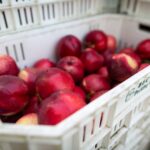California oranges look good in the long term despite potential problems, industry members say

After experiencing several ups and downs over the course of the past few years, California citrus producers say that the orange industry is currently doing well. Many predict that it is likely to stay that way, although some see difficulties ahead.
Speaking with FreshFruitPortal.com, Casey Creamer, president of California Citrus Mutual compared the last few years in the citrus industry to a rollercoaster of events. He said that the trade dispute with China and then Covid-19 were two big factors which “put some downward pressure on the market and had some pretty significant impacts for the growers as far as profitability”.
However, last March things two events caused conditions to take a turn for the better according to Creamer. These were the reduction on tariffs to China and changes in consumer habits as more people began eating more meals at home and focusing on vitamin C as a result of the Covid-19 pandemic.
“[This] really strengthened the citrus market at the tail end of our season, the latter half of our season,” said Creamer. “We've gone from really good a few years ago, to being really, really down and this year, as the season's started, I think we've carried over a good market at the start of the season.”
This seems to be an outlook held by figures within the citrus industry as well. Keith Wilson, sales manager for Cecelia Packing Corporation also stated that this season seemed to be going well, saying “so far this year pricing and movement seem to be up even a little bit versus last season.”
Trends and developments in citrus
Moving forward, producers are not expecting more acres to be planted. However, there was some speculation that low-producing acres would be removed or redeveloped to have blocks of more trees per acre.
Additionally there been a shift in demand toward mandarins, which have grown in popularity due to their convenience and portability, that is forecast to continue.
According to Jesse Silva, sales manager at Kings River Packing, there are several different varieties within the mandarin commodity, and demand for those varieties is picking up.
“A lot of growers are expanding on a lot of different variety types with citrus that is coming into production,” he said. “There are a lot of new opportunities in the citrus base within retail. There's a lot of demand for mandarins and navels. [These] are all continuing to increase. A lot of specialty citrus.”
Potential problems in the industry
Despite this positive start, producers are aware of potential difficulties that could emerge in the next few years. However, most of these possible issues were common difficulties that are not necessarily new to the industry such as labor shortages, dry weather, and pest management.
“As a grower certainty is something you strive for and hope for, but growing a crop is an art and a science, and there are a lot of unpredictables between water, pests, labor, and you name it,” said Creamer.
That said, he also predicted difficulties stemming from the Sustainable Groundwater Management Act (SGMA) which was signed in 2014 and aims to halt overdraft and bring groundwater basins into balanced levels of pumping and recharge by 2040 for critically over-drafted basins, and 2042 for other high and medium priority basins.
“You're going to see some increases in the cost of water and some growers, unfortunately, do not have access to a secure water supply to be able to continue with their operations. That's going to be the biggest thing, I think, that's going to be affecting from a regulatory standpoint moving forward and is on top of grower's minds,” he said.
Bianca Kaprielian of Fruit World also expressed some unease in regards to the supply of organic citrus. This company works primarily with organic navel oranges with a small navel crop that is currently transitioning from traditional to organic.
Kaprielian stated that the demand for organic oranges and conventional mandarins, in general, began picking up in November and tracking over last year, but she had some concerns about there being issues with meeting the demand in the future.
“Currently, there's sufficient supply to meet the rising demand, but overall in California the navel crop, in particular, the organic navel crop is shorter this year and so it's looking like, as an industry, in California [...], organic navel supply is going to end early,” she said.
A bright future
With all that said, the overall outlook for the industry in the longterm is generally viewed to be bright with technology and new programs helping growers to cope with water and labor shortages in addition to a renewed interest in citrus.
“I think there's a bright, bright future for California citrus as a whole, as an industry,” said Jesse Silva “We're always evolving and working on consumer demands












































